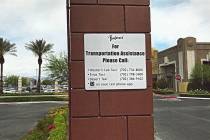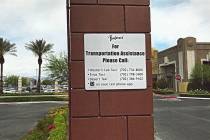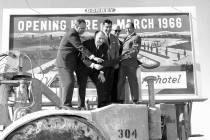Goodbye to scamming, scheming Silver King, who had mettle if not metal
'Tis the time of year when we look at people who have died throughout 2012, even the scamps and scalawags.
One such rogue was James Ray Houston, who died Jan. 25 at the age 68, according to prison records.
Don't recognize the name? Former Nevada Archivist Guy Rocha summed it up well. "James Ray Houston essentially tried to hustle the state."
Back in 1974, when the self-proclaimed Silver King was 28, he was wooing Nevada voters, seeking the governorship as an Independent American. If elected, he wanted to change the monetary system.
He was crushed by popular Gov. Mike O'Callaghan, but despite only being a resident since 1969, Houston ran almost even with the Republican candidate.
When KSNV-TV, Channel 3's Tom Hawley broke the news recently that Houston had died in a federal prison where he was serving 10 years for wire fraud in an international lottery scam, a lot of memories came back.
First and foremost was how Las Vegas Sun reporter Harold Hyman broke into Houston's silver vault, discovered there was no silver and did an exposé just before the election. Hyman was aided by Houston's security guard Rod Franklin, who had been sending anonymous letters saying the Silver King had no silver.
Photos of an empty vault and the newspaper's disclosure that Houston owed $2.4 million still didn't stop more than 26,000 Nevadans from falling for Houston's hustle and voting for him.
I had the distinction of covering Houston's trial in 1978 when the founder of the Western Pacific Gold and Silver Exchange with offices in 30 states was accused of scamming more than 1,100 people out of $3 million, a lot of money then and now.
I watched as he testified over several days, charming jurors who found him not guilty after swallowing his story that he never intended to defraud anyone.
I'm ashamed to say I went to the party he threw afterward to celebrate his victory. To my horror, I was given a engraved plaque for "Outstanding Journalist in the trial of James Ray Houston."
The verdict was an embarrassment for the U.S. attorney's office and enhanced the reputation of the late Las Vegas defense attorney John Fadgen.
Everyone knew that Houston was a scam artist, whether he was convicted or not. He was a man with multiple aliases, Social Security numbers, even birth dates. He made false claims about his past. No, he was not a descendant of Texas legend Sam Houston, despite his saying so.
After his acquittal in federal court, he tried to make a comeback, snatching more headlines for his new companies such as the Great Western Penny Exchange and the Metric Monetary Mint. He was always promising that his newest venture would pay off the people who had lost their money investing with him.
It wasn't completely clear what Houston did during the 30 years after he left Las Vegas around 1981. An occasional newspaper would report he had been investigated for various scams in various states, including California and Georgia.
In 2011, a California newspaper reported that Houston was the last of five defendants sentenced in a lottery scam that cheated thousands of mostly elderly people in the United States and Canada out of more than
$25 million over 16 years. A few victims received money, but the rest went to the scammers, your typical Ponzi scheme.
My favorite Houston story was about how he was captured two years after fleeing Las Vegas, a tale of a federal agent's determination and an airline pilot's rigid instance upon following the rules.
Monday's column continues the saga of a con man who fulfilled many people's expectations by ending his days in prison.
Jane Ann Morrison's column appears Monday, Thursday and Saturday.
Email her at Jane@reviewjournal.com
or call 702-383-0275. She also blogs at
lvrj.com/blogs/morrison.

















